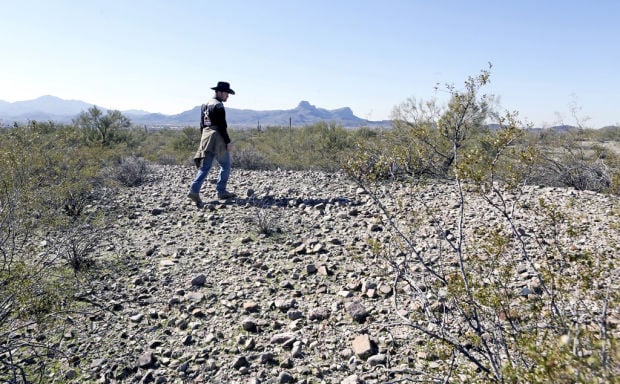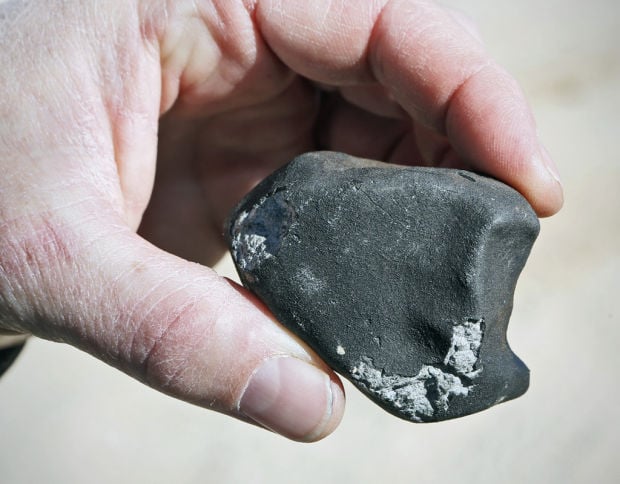Tucson is the epicenter of a meteorite hunt after a shower of space rocks landed north of the city Tuesday night.
The event began at 7:11 p.m. with a window-rattling sonic boom, as a massive fireball entered the Earth’s atmosphere and broke apart. However, the fireball wasn’t precisely a “meteor.”
“Meteor is a phase, and not an actual thing. It’s a transient, luminescent event,” said Eric Christensen, a University of Arizona astronomer. “A meteoroid is what’s in space and passes through the atmosphere and if anything survives to hit the ground that’s what we call a meteorite. Very large meteoroids are called bolides. This may be classified as a bolide event.”
Christensen said Tuesday night’s fireball likely was unrelated to the Geminids meteor shower that is expected to peak over the next two days.
Christensen, as the principal investigator for the Catalina Sky Survey, said there is great scientific value in examining newly fallen meteorites.
“Anytime that we can get a fresh sample of a meteorite that hasn’t been contaminated from sitting on the ground for days or weeks or years — or centuries or millennia, for that matter — it’s a chance to examine a pristine sample of an asteroid,” he said.
Or at least “relatively pristine,” he said. “It is altered as it comes through the atmosphere, and as it sits on the ground, it begins the process of weathering.”
Because of the scientific value of the meteorites, Christensen encourages anyone who finds one to take a photo of it, and if possible, note the GPS coordinates and send them to the UA’s Lunar and Planetary Laboratory. If they wanted to collect the sample and give it to the lab, they should avoid handling it or using a magnet to test it for iron content.
“People will use magnets because a lot of meteorites contain iron. Once you do it, you scramble whatever remnant magnetic field was already in the meteorite, so you lose some of the information already by doing that,” he said. “Our hands have dirt and oil and moisture and any of that that starts to penetrate into the meteorite can contaminate it.”
He suggests rock hunters handle the meteorite as little as possible, put it in a bag and take it to the planetary lab.
“We learn an awful lot about the solar system — the early part of the solar system, the modern processes in the solar system — from studying meteorites,” said Mark Sykes, director and CEO of the Tucson-based nonprofit Planetary Science Institute. “They’re very valuable from a scientific standpoint … to collect, particularly if we can collect it shortly after it hits the ground. As soon as it comes through the Earth’s atmosphere, they start becoming affected by the environment. Being able to get to something very quickly is important.”
Southern Arizona isn’t any more likely than anyplace else in the world to receive meteorite strikes, but “Tucson is one of the world centers of solar system exploration, so there’s a lot of interest here — professional interest as well as popular interest,” Sykes said.
By sunup Wednesday, a cadre of meteorite hunters was already combing Tucson’s northwest side, where the bulk of the space rock was thought to have landed.
Robert Ward of Prescott is a volunteer field researcher representing the Chicago Field Museum. He travels the world looking for meteorites and is especially excited that the bolide essentially broke up in his backyard. He arrived here Wednesday morning and was joined by his team of hunters, who spent the day scouring the desert near West Linda Vista Boulevard and North Linda Vista Place for walnut-sized chunks of meteorite.
Areas where the searchers are focusing include the intersections of West Linda Vista Boulevard and North Linda Vista Place, West Ina Road and North Thornydale Road, and West Ruthrauff Road and North La Cholla Boulevard.
Ward and other meteorite hunters use a combination of eyewitness accounts and Doppler radar to determine where meteorites likely landed.
Doppler radar provides velocity data about objects at a distance by beaming microwave signals toward a target, listening for its reflection, and analyzing how the frequency of the returned signal is altered by the object’s motion.
Through Doppler, meteorites appear as hail, Ward said. Those images combined with the velocity return data tell Ward that the objects that hit the ground were meteorites.
“This was a very large fireball,” he said. “I may chase something this big three or for times a year, but that’s worldwide. To have something like this fall in my backyard is big.
“There was a lot of energy released, and that tells me there was a lot of mass to the object. It fell in the hornet’s nest. It’s the meteorite mecca of the world, Tucson. This is going to be big for Tucson.”
Ward collects and sells meteorites but is primarily interested in providing them for scientific advancement.
He has donated some of his finds to the UA, Christensen said.
As of midday Wednesday, Ward hadn’t found anything on the northwest side, but was confident he and his colleagues were searching in the right area. The meteorites they are looking for can range in size from a pea to a watermelon. If sold, they could fetch $10 to $20 a gram, he estimated.
Christensen, who also collects meteorites, said there can be “a mutually beneficial collaboration” between scientists and hunters.
“Both interests can benefit from each other,” Christensen said. “If a meteorite hunter finds a meteorite and they want to donate a small part of the meteorite to science, that will increase the profile of the meteorite and thereby increase the price.
“The collector community and the scientific community, in the best sense, can really work together. That doesn’t always happen, unfortunately. Meteorites can be valuable, and witness falls (space rocks recovered shortly after hitting the ground) can be even more valuable. Witness falls in the U.S. can be even more valuable, and witness falls in the U.S. over Tucson can be even more valuable. That tends to price some of the scientists out of being able to afford samples.”






